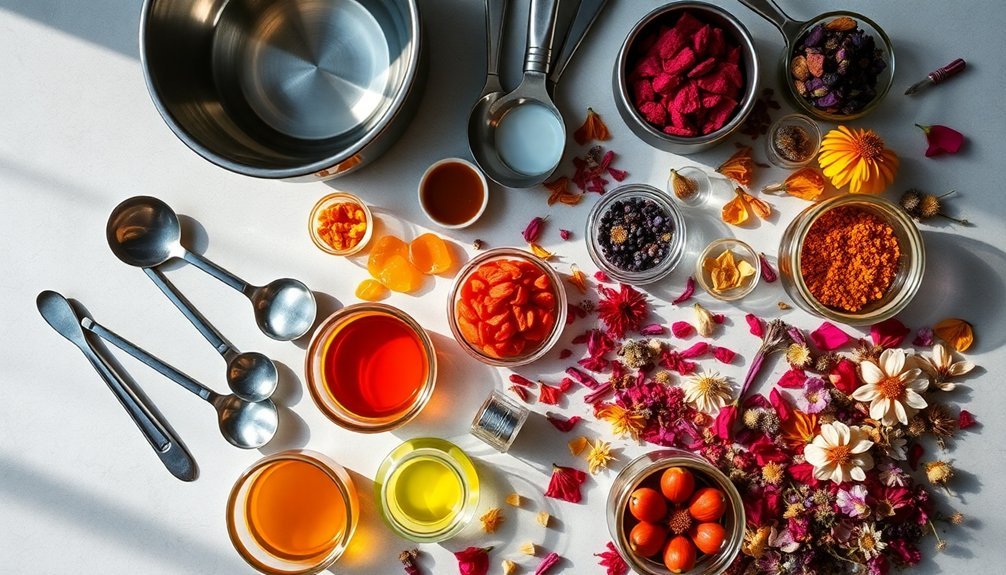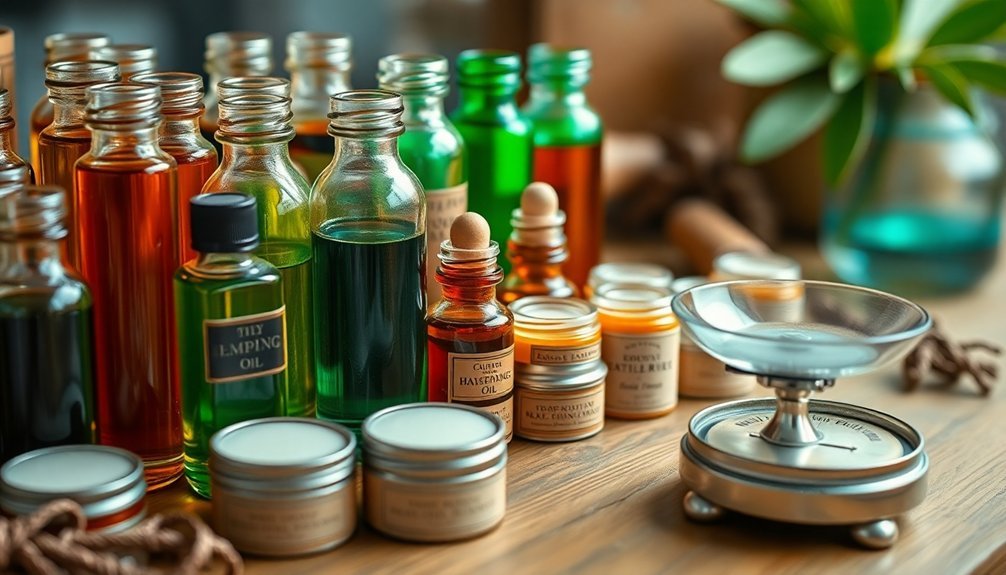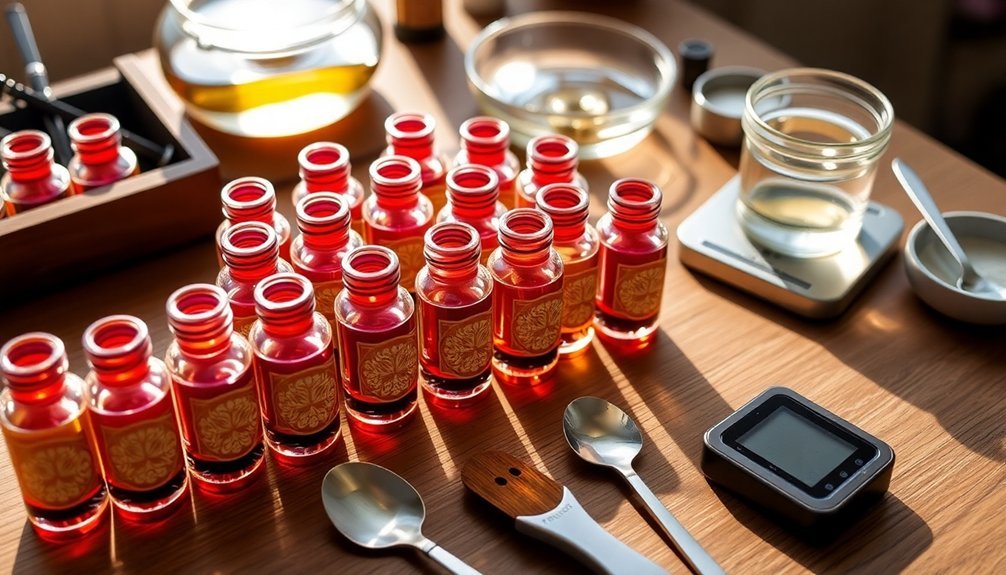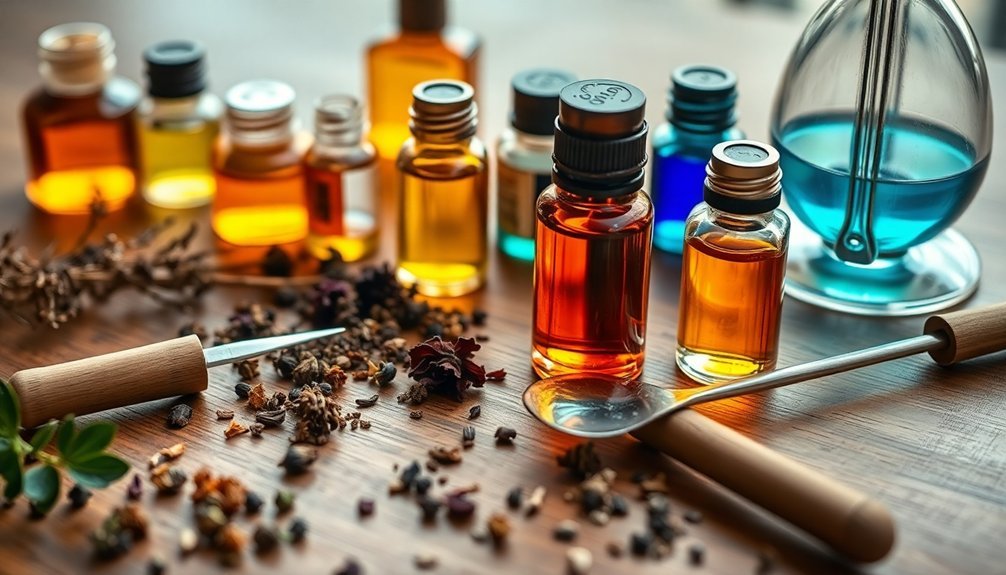To create master-level solid perfumes, you'll need precise digital scales, proper safety gear, and temperature-controlled equipment. Start by following the 30-60-10 rule for note layering, combining top, middle, and base notes while maintaining ideal wax-to-oil ratios between 2:1 and 4:1. Use natural fixatives like benzoin and frankincense at 3-5% concentration, and store your creations in dark glass containers at 15-20°C. These fundamentals lay the groundwork for exploring advanced perfumery techniques.
Essential Equipment and Materials for Professional Solid Perfume Creation

The creation of professional solid perfumes demands a well-equipped workspace with precise tools and materials.
Crafting professional solid perfumes requires precision equipment and a dedicated workspace to ensure quality and consistency.
You'll need digital scales for exact measurements, glass beakers for mixing, and a reliable double boiler or microwave for melting ingredients. Don't overlook essential safety gear like rubber gloves, safety glasses, and protective masks.
For precise blending, you'll want quality stirring rods, pipettes, and metal spatulas to handle various ingredients effectively. Temperature control is vital, so keep a thermometer handy.
When it's time to package your creations, you'll need slimline lip balm tubes, glass bottles, and proper labeling materials. Make sure to organize your workspace with filling trays and protective covers to prevent spills and cross-contamination during the blending process. For optimal quality and consistency, aim for a 10% fragrance oil concentration in your solid perfume blends.
Understanding the Science Behind Note Layering in Solid Perfumes
Building on your well-equipped workspace, mastering the scientific principles behind note layering transforms solid perfume creation from simple mixing to sophisticated artistry.
You'll need to understand how volatility affects your fragrance's evolution and longevity, while managing olfactory fatigue to maintain sensitivity throughout the blending process. Understanding the fragrance wheel categories helps ensure harmonious note combinations in your blends.
When crafting your solid perfumes, focus on these critical scientific principles:
- Combine notes with different evaporation rates to create a dynamic scent that unfolds gradually, placing more volatile components at the top and stable bases at the bottom.
- Leverage synergistic effects by pairing complementary fragrance families, enhancing the overall complexity of your blend.
- Control diffusion and projection by carefully balancing molecular structures, allowing you to create either intimate skin scents or more projecting fragrances.
Advanced Ratio Techniques for Balancing Fragrance Components

You'll need to understand precise note ratio mapping to create professional-quality solid perfumes, starting with the standard 30-50-20 distribution across top, middle, and base notes.
When working with base layers, you can apply proportioning methods that account for both wax-to-oil ratios and fragrance concentrations, typically adjusting between 50-80% for enhancers and 10-15% for equalizers. Creating accurate ratios is enhanced by using diluted ingredients rather than pure materials.
Complex blending scale theory helps you factor in climate considerations and ingredient potency, ensuring your final product maintains stability while delivering the intended aroma profile.
Precise Note Ratio Mapping
Mastering precise note ratios forms the foundation of advanced solid perfume creation. You'll discover that different fragrance types require unique proportions of top, middle, and base notes to achieve the desired effect.
While traditional ratios like 3:2:1 provide a starting point, you'll need to adjust these based on your specific blend's character and intended use.
For professional-level perfume creation, focus on these essential ratio principles:
- Middle notes should comprise 50-75% of your blend to establish the fragrance's core identity.
- Base notes typically make up 5-10% to provide depth without overwhelming.
- Top notes fill the remaining percentage, creating initial impact.
Track your combinations carefully using a spreadsheet method, and allow your blends to mature for several days.
This patience lets you evaluate the true character of your ratios and make precise adjustments.
Base Layer Proportioning Methods
While crafting solid perfumes requires precision at every stage, the art of base layer proportioning stands as the cornerstone of professional fragrance development.
You'll need to start by organizing your fragrances into main themes and accent groups, focusing first on your heaviest concentrations.
Begin with a 2:1 ratio of your primary base notes to supporting scents, then adjust based on the specific fragrance families you're working with.
If you're using perfume oils, apply them first and let them settle before adding lighter concentrations.
Test small amounts on your skin, allowing the blend to mature for several days to evaluate its true character.
Remember to keep your skin well-moisturized, as this greatly impacts how the fragrances interact and develop their final harmony.
Complex Blending Scale Theory
Beyond basic ratios lies the intricate world of Complex Blending Scale Theory, where precise proportions and chemical harmonies determine a solid perfume's ultimate character.
You'll need to master both the art and science of note sequencing, understanding how each component interacts over time.
To elevate your blending technique, focus on these critical elements:
- Start with a foundation ratio of 30% top notes, 50% middle notes, and 20% base notes, then adjust based on your desired fragrance profile.
- Allow for proper maturation periods, typically 3-7 days, to evaluate the true character of your blend.
- Use sequential blending methods to maintain control, adding components gradually while monitoring chemical compatibility.
Remember to document your proportions using spreadsheets, especially when working with diluted ingredients, to guarantee consistency in future batches.
Mastering the Art of Wax-to-Oil Proportions

To achieve professional-quality solid perfumes, you'll need to master the delicate balance between waxes and oils in your formulations.
Start by understanding how different waxes, like beeswax and Cera Bellina, interact with carrier oils such as jojoba and sweet almond.
Your wax-to-oil ratio will typically range from 2:1 to 4:1 by weight, but you'll need to adjust based on your climate and desired consistency.
While volume measurements are common, weighing ingredients provides more accurate results. Test your blends in various environments to guarantee stability.
Consider your fragrance concentration carefully, aiming for 10-15% of the total mixture.
When working with essential oils, maintain the classic perfume structure by blending your base, heart, and top notes in a 2:1:1 ratio for a well-balanced scent profile.
Expert Methods for Incorporating Natural Fixatives
Mastering the art of natural fixatives separates amateur perfumers from professionals in solid perfume creation.
You'll discover that classic fixatives like benzoin and frankincense not only extend your blend's longevity but also add sophisticated depth to your compositions.
To expertly incorporate natural fixatives into your solid perfumes:
- Start with a base of beeswax and combine it with labdanum or myrrh for a stable foundation that anchors volatile top notes.
- Layer storax between your middle notes to create a seamless bridge between top and base notes.
- Add a small percentage of benzoin (typically 3-5%) at the final stage to lock in the entire composition.
You'll find that these natural fixatives work synergistically with your chosen essential oils, creating a more nuanced and longer-lasting solid perfume.
Creating Signature Blends: Beyond Basic Combinations

Now that you've mastered natural fixatives, the art of creating signature blends opens up endless possibilities for your solid perfume journey.
Start by selecting your fragrance concept, whether it's floral, woody, or oriental, then carefully layer your notes following the 30-60-10 rule: 30% top notes, 60% middle notes, and 10% base notes.
You'll want to combine complementary scents within each layer. Try pairing citrus top notes like bergamot with floral middle notes such as jasmine, anchored by woody base notes like sandalwood.
Remember to test small batches and allow your blends to mature before making final adjustments. As you experiment, don't hesitate to break traditional combinations – sometimes unexpected pairings create the most distinctive signatures.
Temperature Control Strategies for Perfect Consistency
Achieving the perfect solid perfume consistency depends heavily on precise temperature control during both melting and cooling phases.
You'll need to heat your ingredients to 90-95°C in a beaker for complete melting, but don't add your fragrance until everything else has fully liquefied to preserve its integrity.
For ideal results, follow these critical temperature control steps:
- Heat waxes and silicone compounds gradually, monitoring to prevent degradation.
- Add fragrances only after the base has cooled slightly but remains liquid.
- Allow undisturbed cooling below 54°C in pre-prepared containers.
You'll know you've mastered the process when your solid perfume solidifies with a smooth, crystal-free finish.
Remember that smaller containers will cool faster, and you should wait 24 hours before testing your final product.
Advanced Preservation Methods for Extended Shelf Life

When crafting your solid perfumes for longevity, you'll want to incorporate natural preservatives like vitamin E and rosemary extract while monitoring oxidation through regular shelf-life testing.
You can maximize preservation by storing your creations in airtight, dark-glass containers at temperatures between 15-20°C (59-68°F) and maintaining relative humidity below 60%.
To extend shelf life even further, you'll benefit from adding antioxidants like BHT or tocopherol while conducting monthly stability checks to assess color, texture, and fragrance integrity.
Natural Preservatives and Antioxidants
Three key factors determine the longevity of your solid perfume: natural preservatives, antioxidants, and proper formulation techniques.
To maximize shelf life, you'll want to incorporate powerful plant-based preservatives like vitamin E oil and rosemary extract, which work synergistically to prevent oxidation and rancidity.
- Combine multiple essential oils with antimicrobial properties, such as tea tree, lavender, and thyme, to create a robust preservation system.
- Utilize antioxidant-rich extracts like green tea and grape seed to protect your fragrance compounds.
- Strengthen your formulation by blending complementary waxes with jojoba oil as a stabilizer.
For enhanced protection, consider adding a combination of tocopherol and beta-sitosterol to your base.
These natural preservatives won't compromise your perfume's scent while ensuring its stability over time.
Storage Environment Best Practices
Proper storage conditions serve as the cornerstone of preserving your solid perfume's integrity and extending its shelf life. You'll want to maintain a temperature range of 15-20°C while keeping your creations in low-humidity, climate-controlled environments. For ideal preservation, store your blends away from direct sunlight and heat sources.
| Storage Factor | Do's | Don'ts |
|---|---|---|
| Temperature | Keep at 15-20°C | Avoid extreme heat/cold |
| Light | Use dark containers | Never place in sunlight |
| Humidity | Store in dry areas | Skip bathroom storage |
| Air Exposure | Use airtight containers | Don't leave open |
| Handling | Apply with dry hands | Never use wet fingers |
For professional-grade preservation, you might consider investing in a perfume fridge to maintain consistent conditions. Remember to keep your solid perfumes away from windows, radiators, and humid spaces to maximize their longevity.
Shelf-Life Testing Methods
Mastering shelf-life testing methods requires a sophisticated approach to preservation that combines multiple evaluation techniques.
You'll need to employ both accelerated and real-time stability testing to accurately predict your solid perfume's longevity. Using climate chambers and UV light cabinets, you can simulate various environmental conditions that your fragrance might encounter.
To guarantee thorough testing of your solid perfume, implement these critical methods:
- Conduct freeze-thaw cycles to evaluate physical stability and texture consistency
- Perform microbiological testing to verify preservation system effectiveness
- Use spectrophotometric analysis to detect any changes in color or clarity
Your testing protocol should integrate sensory evaluation alongside instrumental analysis.
Troubleshooting Common Solid Perfume Formulation Issues

When crafting solid perfumes, even experienced perfumers encounter formulation challenges that can affect the final product's quality.
You'll need to monitor several vital aspects to troubleshoot effectively. Watch for inconsistent melting points, which can make your perfume too soft or hard, and guarantee proper mixing of waxes and oils to prevent separation.
To address fragrance issues, you'll want to adjust essential oil concentrations carefully while maintaining a safe pH level between 4 and 8.
If you notice fading scents, evaluate your carrier oil choice and binder materials.
Pay attention to texture problems by allowing proper cooling time to prevent crystallization.
Test your formulations through organoleptic evaluation, and don't forget to check spreadability and adhesion.
Remember that proper storage conditions are essential for maintaining stability and extending shelf life.
Scaling Up: From Small Batches to Professional Production
Shifting from small-batch to large-scale perfume production requires a fundamental shift in your measurement approach.
Transitioning to mass perfume production demands precision and a complete overhaul of your measurement methods for consistent quality.
You'll need to abandon drop measurements in favor of weight-based formulations using precise electronic scales. This change guarantees consistency across larger batches and professional-level quality control.
For successful scaling, focus on these critical steps:
- Convert your existing formulas to weight percentages, making it easier to scale to any batch size.
- Invest in proper equipment like stainless steel mixing tanks and filtration systems.
- Implement temperature-controlled aging processes for peak maturation.
You'll also need to establish standardized procedures for quality control and maintain detailed documentation of your production methods.
Remember to factor in longer maturation times for larger batches and adjust your formulation process accordingly.
Frequently Asked Questions
How Do Seasonal Temperature Changes Affect Solid Perfume Storage Requirements?
You'll need to protect your solid perfumes from temperature swings by storing them between 15-25°C. Keep them in airtight containers, away from sunlight, and in climate-controlled spaces to prevent degradation and texture changes.
Can Solid Perfumes Be Safely Layered With Commercial Liquid Fragrances?
Yes, you can safely layer solid perfumes with commercial liquid fragrances. Apply your liquid fragrance first, let it dry, then add the solid perfume on pulse points for a unique, long-lasting scent combination.
What Causes Some Solid Perfumes to Develop a Grainy Texture?
Your solid perfume can become grainy when it's exposed to temperature changes, improper cooling, or incorrect wax-to-oil ratios. Rapid temperature shifts and poor ingredient mixing are the main culprits.
How Do Different Skin Chemistry Types Interact With Solid Perfume Bases?
Your skin's pH and oil levels directly affect how solid perfumes perform. If you've got oily skin, you'll notice stronger scents, while dry skin makes fragrances fade faster. Combination skin yields varying results.
When Should Synthetic Stabilizers Be Chosen Over Natural Alternatives?
You should choose synthetic stabilizers when you need guaranteed longevity, consistent batch quality, and complex fragrance profiles. They're also more cost-effective and can help protect endangered species by reducing demand for natural alternatives.





Leave a Reply